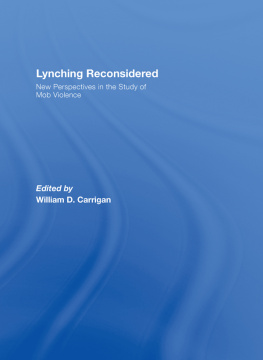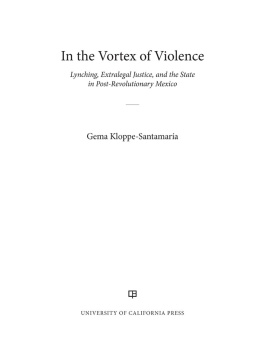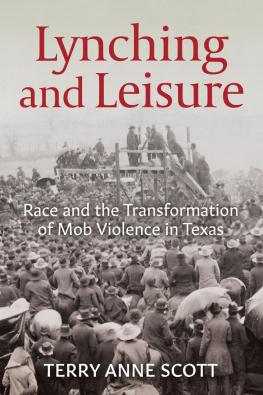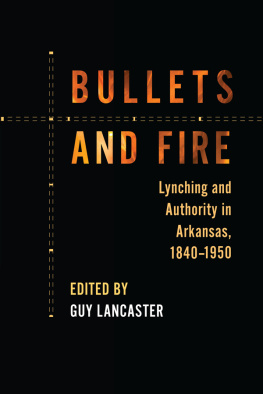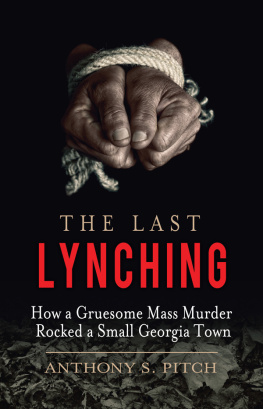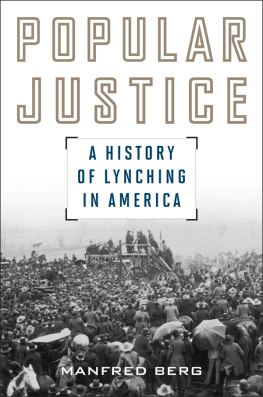Lynching Reconsidered
The history of lynching and mob violence has become a subject of considerable scholarly and public interest in recent years. Popular works by James Allen, Philip Dray and Leon Litwack have stimulated new interest in the subject. A generation of new scholars, sparked by these works and earlier monographs, are in the process of both enriching and challenging the traditional narrative of lynching in the United States.
This book contains essays by ten scholars at the forefront of the movement to broaden and deepen our understanding of mob violence in the United States. These essays range over the period from Reconstruction to World War II, analyze lynching in multiple regions of the United States and employ a wide range of methodological approaches. The authors explore neglected topics such as lynching in the Mid-Atlantic, lynching in Wisconsin, lynching photography, mob violence against Sicilian Italian immigrants, black lynch mobs, grassroots resistance to racial violence by African Americans, nineteenth century white southerners who opposed lynching and the creation of lynching narratives by southern white newspapers. The book speaks to patterns of violence, racism and resistance that are central to the history of the United States.
This book was first published as a special issue of American Nineteenth Century History.
William D. Carrigan is associate professor of history at Rowan University in Glassboro, New Jersey. His first book was The Making of a Lynching Culture: Violence and Vigilantism in Central Texas, 18361916. He is currently at work with Clive Webb on a study of mob violence against Mexicans in the United States.
First published 2008 by Routledge
2 Park Square, Milton Park, Abingdon, Oxon OX14 4RN
Simultaneously published in the USA and Canada
by Routledge
270 Madison Avenue, New York, NY 10016
Routledge is an imprint of the Taylor & Francis Group, an informa business
2008 William D. Carrigan
Typeset in Minion by Genesis Typesetting Ltd, Rochester, Kent
Printed and bound in Great Britain by MPG Books Ltd, Bodmin, Cornwall
All rights reserved. No part of this book may be reprinted or reproduced or utilised in any form or by any electronic, mechanical, or other means, now known or hereafter invented, including photocopying and recording, or in any information storage or retrieval system, without permission in writing from the publishers.
British Library Cataloguing in Publication Data
A catalogue record for this book is available from the British Library
Library of Congress Cataloging in Publication Data
A catalog record has been requested
ISBN 10: 0-415-36676-3 (hbk)
ISBN 13: 978-0-415-36676-2 (hbk)
CONTENTS
William D. Carrigan
Michael J. Pfeifer
Janice Hittinger Barrow
Bruce E. Baker
Christopher Waldrep
Kidada E. Williams
Susan Jean
Amy Louise Wood
Clive Webb
W. Fitzhugh Brundage
William D. Carrigan
I was twenty years old when I decided to devote myself to the study of lynching and mob violence in the United States. Although I had loved history for years, my initial major at the University of Texas at Austin was mechanical engineering because I couldnt answer the question put forward by my parents, So, what can you do with that degree other than teach? I now know you can do much with a history degree. But I didnt have a good answer at the time and dutifully enrolled in a major that might lead to a nice career. The experiment didnt last too long, principally due to my own lack of interest in the subject matter. Calculus, however, must also share some of the blame.
After fleeing engineering, I was encouraged by a friend to take a United States history class taught by George C. Wright. He had just won a teaching award from the university and was reputed to be a dynamic lecturer. So, my friend and I enrolled in his class, which met at 8 oclock in the morning. It was a fateful decision. Professor Wright would eventually become the advisor of my honors thesis and push me to attend graduate school. I also eventually married the friend who recommended the course to me.
George Wright was a specialist in lynching and mob violence, and I still remember when he showed images and photographs of several lynchings to our class. At least one of the photographs was of Jesse Washington, a black 18-year-old farm worker who was lynched in 1916 before a crowd of some 15,000 people in Waco, Texas. The grisly images shocked me. I had grown up north of Waco in a little community called Chalk Bluff. While my family had only moved to the region after World War II, I still nevertheless felt sick looking at the crowd. I wondered what I would have done if I had grown up in the early part of the twentieth century instead of the latter part. Would I have joined the crowd and endorsed this brutal burning of a human being? It was a disturbing question. I knew what I hoped would be my answer, but that didnt help. I wanted to understand how so many people could come to believe that lynching was an acceptable means of dispensing justice. The question that drove me was akin to the question that drives some scholars of the Holocaust: how did ordinary Germans come to support or at least tolerate what was happening around them?
So, for the last dozen years or so, I have been trying to figure out why ordinary Americans participated in and accepted lynching. One result of all this work was my dissertation, now published by the University of Illinois Press as a monograph under the title The Making of a Lynching Culture: Violence and Vigilantism in Central Texas, 18361916. The collection of essays that you now hold in your hands is a second attempt to understand lynching and mob violence in the United States.
In conducting the research for my own book and in traveling the conference circuit, I came across many folks like me. These were scholars, young and old, who had been influenced by the outpouring of lynching scholarship in the 1980s and early 1990s. They were doing fascinating work that often pushed the boundaries chronological, geographical, and topical that framed much of the discussion of lynching. I began thinking that collecting this new scholarship would make a powerful volume of essays that would help chart the future direction of research on mob violence. When Martin Crawford asked me to be the assistant editor of American Nineteenth Century History, I didnt wait long to bring up my idea. Martin endorsed the idea immediately, and he and fellow editor Susan-Mary Grant have provided sterling support ever since.
The essays that follow have been chosen because they illustrate the ways in which I think the academic community should reconsider lynching. For decades, the subject of lynching was largely ignored by the academy. American history textbooks said little of the subject, and the historical professions leaders did not think it a topic worthy of much research. That began to change in the 1960s when the Civil Rights Movement sparked widespread interest in race relations and African American history. Scholarship on lynching slowly grew, culminating with the publications of W. Fitzhugh Brundages Lynching in the New South: Georgia and Virginia, 18801930 and Stewart Tolnay and E. M. Becks A Festival of Violence: An Analysis of Southern Lynchings, 18821930. The cumulative impact of this scholarship made a difference, and many American history textbooks now at least mention lynching and mob violence.

